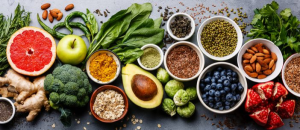 Did you know that turmeric is highly alkalizing?
Did you know that turmeric is highly alkalizing?
When it comes to improving health, very little you do matters more than improving your acid-alkaline balance with an alkaline eating plan. Your body is essentially millions of chemical reactions that work best in an alkaline environment. Using our 3XR Curcumin Super Blend Powder or Factor 8 Joint Ease capsules will really help create and maintain these conditions.
Curcumin increases the level of immunity-boosting proteins in our bodies which help fight bacteria and viruses when they try to attack.
Is your diet acid-forming or alkaline-forming?
Eating “alkaline” means that you’re trying to keep your body’s acid base (pH) between 6.5 (slightly acidic) and 7.5 (slightly alkaline). Most of the food we eat has the potential to alter our pH. When digested, some foods leave acidic by-products in the body (acid-forming foods); others leave alkaline by-products (alkaline-forming foods).
Alkaline v Acid diet..
- Acid-forming foods include most high-protein foods, such as meat, fish, eggs, and most legumes (beans and peas – except lentils, which are alkaline-forming). Sugar, coffee, alcohol, diary and most grains are also acid-forming.
- Alkaline-forming foods include nearly all vegetables and fruits, many nuts and seeds, and spices, especially turmeric.
Our Stone Age ancestors ate hundreds of different types of natural whole foods. Seeds, nuts, vegetables, fruits, and roots were supplemented with game animals and fish, providing on average a pH-balanced diet. Our organs and body systems evolved in adaptation to this diet. It’s as if Nature said, “You can eat acid-forming meat, beans, and other high-protein foods, but you must balance these with an abundance of the alkaline-forming vegetables, fruits, nuts, seeds, and spices.” And for thousands of years, that’s exactly what we did.
What are problems with an acid-forming diet?
Unfortunately, we’ve strayed from the acid-alkaline balanced diet that our ancestors achieved. We favour meat, sugars, grains, low-mineral processed foods, and other acid-forming foods and get far too few alkaline-forming vegetables, fruits, nuts, and seeds.
The net result is that our eating patterns create a condition known as “chronic low-grade metabolic acidosis.” While our bodies can easily handle an occasional acid load, long-term acid build-up can exhaust our available alkalizing reserves. Unless we take steps to neutralize these acids, they can damage our health in many ways — and this is the underlying cause of many of our modern health problems.
How to start an alkaline diet plan
If you have symptoms of acid imbalance, eat 80% of your foods from the alkaline-forming group. The other 20% can be high protein items and other acid-forming foods.
Later, when your pH balance has improved (which you can tell by urine testing or by the fact that your symptoms have resolved), you can lower the alkaline-forming part of your diet to around 65%. Don’t forget to add yourHealth2all turmeric to the mix.
Some general guidelines for eating alkaline:
- Focus on eating whole foods, like vegetables, root crops, fruits, nuts, seeds, spices, whole grains and beans (especially lentils).
- Drink alkalizing beverages such as spring water and ginger root or green tea, water with the juice of a whole lemon or lime. Beware of tap water, often high in chlorine and fluorine, so filter it and don’t forget to add a small pinch of Himalayan or Celtic salt.
- Eat smaller amounts of essential fats, meat, fish, pasta and other grains.
- Eliminate processed and artificial foods, caffeine, white sugar, and white flour.
- Don’t be afraid to use real butter, ghee, and full-fat milk (if you use dairy).
- Dress salads or cook with high-quality fats such as cold-pressed virgin olive oil, coconut oil, or avocado oil